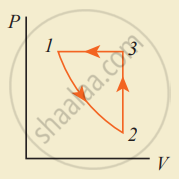Advertisements
Advertisements
प्रश्न
Explain the thermodynamics of the isobaric process.
उत्तर
- A thermodynamic process that is carried out at constant pressure i.e., Δp = 0 is called the isobaric process.
- For an isobaric process, none of the quantities ΔU, Q, and W is zero.
- The temperature of the system changes, i.e., ΔT ≠ 0.
- The energy exchanged is used to do work as well as to change internal energy causing an increase in temperature. Thus, Q = ΔU + W.
- As work is done volume changes during the process.
- Heat exchanged in case of an isobaric process:
a. Consider an ideal gas undergoing volume expansion at constant pressure.
b. If Vi and Ti are its volume and temperature in the initial state of a system and Vf and Tf are its final volume and temperature respectively, the work done in the expansion is given by,
W = pdV = p(Vf – Vi) = nR(Tf – Ti) ….(1)
c. Also, the change in the internal energy of a system is given by, ΔU = nCVΔT = nCV(Tf – Ti) ….(2)
Where, CV is the specific heat at constant volume, and ΔT = (Tf – Ti) is the change in its temperature during the isobaric process.
d. According to the first law of thermodynamics, the heat exchanged is given by, Q = ΔU + W
Using equations (1) and (2) we get,
Q = nCV(Tf – Ti) + nR(Tf – Ti)
∴ Q = (nCV + nR) (Tf – Ti)
∴ Q = nCp(Tf – Ti) .............(∵ Cp = CV + R)
Where, Cp is the specific heat at constant pressure. - The p-V diagram for an isobaric process is called isobar. It is shown in the figure below.

APPEARS IN
संबंधित प्रश्न
Explain why The climate of a harbour town is more temperate than that of a town in a desert at the same latitude.
A thermodynamic system is taken from an original state to an intermediate state by the linear process shown in Figure

Its volume is then reduced to the original value from E to F by an isobaric process. Calculate the total work done by the gas from D to E to F
What is a thermodynamic process?
Draw a p-V diagram of the reversible process.
Draw a p-V diagram showing positive work at constant pressure.
3 mole of a gas at temperature 400 K expands isothermally from an initial volume of 4 litres to a final volume of 8 litres. Find the work done by the gas. (R = 8.31 J mol-1 K-1)
When a cycle tyre suddenly bursts, the air inside the tyre expands. This process is ____________.
Give the equation of state for an isothermal process.
Apply first law for an adiabatic process.
Give the equation of state for an adiabatic process.
Draw the PV diagram for the isobaric process.
What is a cyclic process?
Can the given heat energy be completely converted to work in a cyclic process? If not, when can the heat can completely converted to work?
Explain in detail the isothermal process.
Derive the work done in an adiabatic process.
Explain the isobaric process and derive the work done in this process.
In an adiabatic expansion of the air, the volume is increased by 4%, what is the percentage change in pressure? (For air γ = 1.4)
Consider the following cyclic process consist of isotherm, isochoric and isobar which is given in the figure.

Draw the same cyclic process qualitatively in the V-T diagram where T is taken along the x-direction and V is taken along the y-direction. Analyze the nature of heat exchange in each process.
A thermodynamic system undergoes cyclic process ABCDA as shown in the figure. The work done by the system is ______

Two identical samples of a gas are allowed to expand (i) isothermally (ii) adiabatically. Work done is ____________.
In which of the following processes, beat is neither absorbed nor released by a system?
For an isothermal expansion of a perfect gas, the value of `(Delta "P")/"P"` is equal to ____________.
Assertion: Equal volumes of monatomic and polyatomic gases are adiabatically compressed separately to equal compression ratio `("P"_2/"P"_1)`. Then monatomic gas will have greater final volume.
Reason: Among ideal gases, molecules of a monatomic gas have the smallest number of degrees of freedom.
An ideal gas is compressed to half its initial volume by means of several processes. Which of the process results in the maximum work done on the gas?
The work done on the system in changing the state of a gas adiabatically from equilibrium state A to equilibrium state B is 22.4 J. If the gas is taken from state A to B through another process in which the net heat absorbed by the system is 15.5 cal, then the net work done by the system in the latter case is ______.
( l cal = 4.2 J)
In a certain thermodynamical process, the pressure of a gas depends on its volume as kV3. The work done when the temperature changes from 100°C to 300°C will be ______ nR, where n denotes number of moles of a gas.
Explain the thermodynamic process.
When an inflated ballon is suddenly burst, why is the emerging air slightly cooled?
